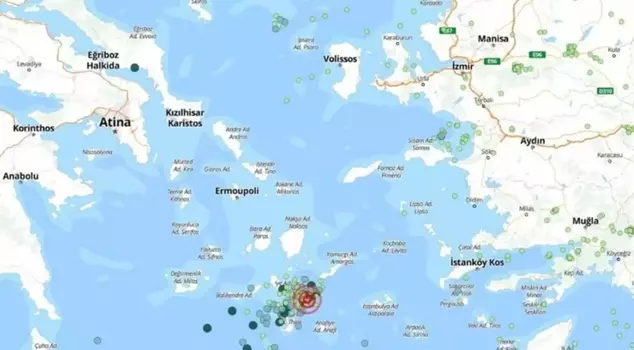
03.02.2025 22:12
With over 400 earthquakes occurring in the Aegean Sea in one week, Greece has entered a state of alert, while a response has also come regarding Turkey. Experts stated that the series of earthquakes that have occurred since January 28 will not trigger the existing fault lines in Istanbul, the Marmara Region, and Anatolia, while emphasizing that the potential tsunami effect will be monitored.
It has been reported that the earthquakes that have been occurring consecutively in the Aegean Sea since January 28 will not trigger the existing faults in Istanbul, the Marmara Region, and Anatolia.
IS THE AEGEAN SEA CONSTANTLY SHAKING?
The consecutive earthquakes in the Aegean Sea have drawn attention to the region. While nearly 500 earthquakes have occurred in the last week, Greece has increased its precautions. Especially, residents of Santorini have started to leave the island.
WILL THE EARTHQUAKES AFFECT TURKEY?
The earthquakes in the Aegean have raised concerns in Turkey as well. As the question of whether Turkey will be affected by the earthquakes is sought with anxiety, experts have provided explanations. Experts evaluated the increased seismic activity on Santorini Island and the possible effects of the earthquakes recorded since January 28 on Istanbul and Anatolia in an interview with AA.
"THE FREQUENCIES OF THE EARTHQUAKES HAVE STARTED TO INCREASE"
Prof. Dr. Nurcan Meral Özel, Director of the Kandilli Observatory and Earthquake Research Institute (KRDAE) at Boğaziçi University, explained that the earthquakes are still continuing within an area of 2,500 square kilometers, and a significant increase in seismic movements has drawn attention. Özel stated that they monitor the region 24/7 as an institute, saying, "This is an active subduction zone located south of the Aegean Sea, where the Hellenic Ridge and the African Plate are beneath the Eurasian Plate... This area has actually been active for 2.5 years. We are continuously recording in the Mediterranean, but the frequencies of these earthquakes have started to increase."
Özel noted that throughout history, many earthquakes and major eruptions have occurred in the region, some of which have caused tsunamis, and continued: "A similar activity was recorded in 2011-2012, with periods of volcanic activity. We already know that the region is constantly in a geodynamic mobility. The activity in the last century is directly related to the seismic movements in the region. However, these are compatible with normal faults and outward-dipping faults. We have also solved the source mechanisms of four major earthquakes. We can say that tectonic factors are effective, and we can evaluate it that way. We can also say that the volcanic characteristics of the region are effective in the activity manifesting as an earthquake storm. However, it is not possible to say anything definitive with the data we have regarding whether the activity shows direct volcanic mobility."
"NO EMERGENCY SITUATION IS OBSERVED IN TURKEY"
Özel stated that the likelihood of both seismic and volcanic events occurring in the region in the future is high. For this reason, she emphasized that a multidisciplinary monitoring system should continuously observe the area, saying, "No emergency situation is observed in Turkey, but we are closely monitoring developments. We think it is beneficial to continue evaluating according to the course of the activity. These are not factors that will affect the Marmara Region. Evaluating the effects in the southwest of Turkey also depends on how the activity will continue. The current activity is along a line located between the north of Crete and the southwest of Turkey. Such a thing cannot have a single connection with all of Marmara." she stated.
Prof. Dr. Şükrü Ersoy, a faculty member at Yıldız Technical University (YTÜ) Faculty of Civil Engineering, pointed out the importance of the location of the earthquake, stating that more than 500 earthquakes, some of which were 4 and above, have occurred in the region over the past week. Ersoy mentioned that Santorini Island in the region is volcanic, saying, "It is an important island that has been active in human history, causing destruction and also creating tsunamis. It is happening right next to it."
Ersoy pointed out that a major earthquake that occurred in the sea near Amargos Island next to Santorini in 1956 caused a tsunami and waves over 5 meters, stating that both volcanic and tectonic earthquakes, as well as tsunamis, can occur here.
"WE ARE MONITORING FOR TSUNAMI"
Ersoy drew attention to the triple danger that could arise in the region, saying, "In this regard, we are continuously monitoring the region, looking at the activities. Similarly, the Greek Crisis Center is also monitoring and making some warnings. We are following the potential effects of an earthquake or tsunami that could occur due to the proximity of Bodrum and Muğla to us." He emphasized that the earthquake storm in the Aegean Sea is also being monitored by AFAD, and necessary explanations are made from time to time to avoid misinformation.
Ersoy stated, "Since this is not exactly our event, it is very normal for the crisis center to be established in Greece, on the island." He noted that the center established in Greece has made logical warnings, stating, "This earthquake storm has no relation to any part of Istanbul and Anatolia, and it is not possible for it to trigger anything. If such things are being said, they are completely wrong and speculative."
EDUCATION HAS BEEN SUSPENDED IN 4 ISLANDS
Due to the increased seismic activity in the Aegean Sea, education has been suspended until Friday in schools on the Greek islands of Santorini, Yamurgi, Niyoz, and Anafiya. Additional transportation services have been organized for citizens who are anxious about the earthquake to leave the island.